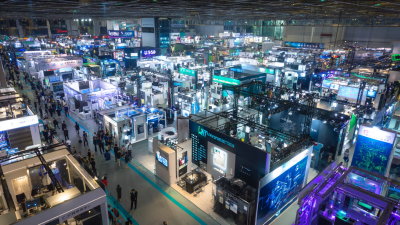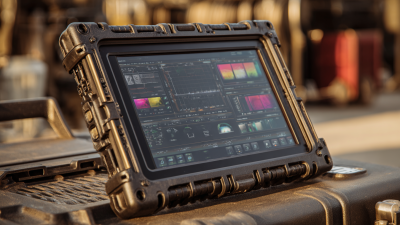Exploring the Future of Industrial Computing Products at the 2025 China Import and Export Fair
As we look forward to the 2025 China Import and Export Fair, also known as the 138th Canton Fair, the spotlight will undoubtedly be on the rapidly evolving landscape of industrial computing products. This event serves as a significant platform for showcasing cutting-edge technologies and innovative solutions that cater to the demands of the modern industrial sector. With advancements in hardware and software driving efficiency and productivity, the exhibition will not only highlight the latest developments but also provide insights into future trends that are shaping the industry. Participants can expect to explore a diverse range of industrial computing products designed to optimize operations, enhance data processing capabilities, and integrate seamlessly with emerging Internet of Things (IoT) applications. As we navigate the intersection of technology and industry, the 2025 Canton Fair promises to be a pivotal moment for stakeholders eager to understand and leverage the transformative potential of these products.

The Evolution of Industrial Computing Products: Key Trends for 2025
The evolution of industrial computing products is witnessing significant transformations as we approach 2025. Emerging trends indicate a strong shift towards enhanced automation and integration of advanced technologies such as AI and IoT. According to Deloitte's 2025 technology industry outlook, companies are increasingly prioritizing investments in digital infrastructure to boost operational efficiency and innovation. This shift is particularly pronounced in manufacturing, where firms are directing resources toward upgrading their digital and data foundations.

Tips: Embrace automation in your processes to reduce costs and increase productivity. Explore partnerships with tech providers focused on AI and IoT solutions to stay competitive in the evolving market.
Furthermore, the semiconductor industry is set to experience a remarkable surge, particularly driven by the demand for AI applications and data center expansions. A recent report estimates that chip sales will soar as industries adapt to the new technological landscape, creating opportunities for industrial computing products to optimize performance and reliability.
Tips: Stay ahead of the curve by investing in state-of-the-art chip technology and leveraging AI capabilities in your industrial computing products. Continuous training and upskilling for your workforce can also help bridge the skills gap in this fast-evolving environment.
Market Growth Projections for Industrial Computing in Asia-Pacific Region
The Asia-Pacific region is poised for significant growth in the industrial computing market, projected to expand from a valuation of $27.92 billion in 2022 to an estimated $35.65 billion by 2030. This growth, driven by advancements in artificial intelligence and increased adoption of digital technologies, reflects a notable compound annual growth rate (CAGR) of 32.4%. North America dominated the market with a 35.6% share in 2022, but the emerging markets in Asia-Pacific are rapidly catching up as industries pivot towards automation and smart manufacturing solutions.
Furthermore, the expected rise in private 5G networks will enhance data transmission speeds and security, offering customized communication infrastructure for enterprises. This shift is essential for industries aiming to harness edge computing capabilities and real-time data analytics, which are becoming increasingly critical in optimizing operational efficiencies. As investments in industrial software and smart technologies grow, the landscape of industrial computing in the region is likely to evolve, indicating robust market dynamics leading towards the middle of the decade.
Exploring the Future of Industrial Computing Products at the 2025 China Import and Export Fair - Market Growth Projections for Industrial Computing in Asia-Pacific Region
| Year | Market Size (USD Billion) | Growth Rate (%) | Key Application Areas |
|---|---|---|---|
| 2021 | 10.5 | 6.0 | Manufacturing, Logistics |
| 2022 | 11.1 | 5.7 | Automotive, Healthcare |
| 2023 | 11.8 | 6.3 | Retail, Telecommunication |
| 2024 | 12.5 | 5.9 | Energy, Agriculture |
| 2025 | 13.2 | 5.6 | Construction, Smart Cities |
Technological Innovations Shaping the Future of Industrial IoT Solutions
As we approach the 2025 China Import and Export Fair, the spotlight is increasingly on the technological innovations that are revolutionizing industrial Internet of Things (IoT) solutions. These advancements are not merely incremental; they represent a paradigm shift in how industries operate, focusing on enhanced connectivity, data analytics, and automation. With smart sensors and devices communicating seamlessly, businesses can gather real-time data, optimize processes, and reduce operational costs. This growing interconnectedness paves the way for unprecedented efficiency in manufacturing, supply chain management, and predictive maintenance.
Moreover, the integration of artificial intelligence and machine learning into IoT systems is transforming decision-making processes within industrial environments. Companies are now able to harness vast amounts of data to gain actionable insights, enabling them to preemptively address issues and enhance productivity. The emergence of edge computing further amplifies these benefits by allowing data processing to occur closer to the source, reducing latency and bandwidth usage. As we explore these innovations at the fair, it becomes clear that the future of industrial computing is not just about technology; it's about creating smarter, more responsive environments that drive growth and sustainability.
Impact of AI and Automation on Industrial Computing Efficiency and Productivity
At the 2025 China Import and Export Fair, the focus on industrial computing products will showcase the transformative impact of AI and automation on operational efficiency and productivity. The integration of advanced algorithms and machine learning technologies is enabling industries to optimize processes, reduce downtime, and enhance decision-making capabilities. As companies adopt AI-driven solutions, they can analyze vast amounts of data in real-time, leading to more informed strategies and improvements in resource management.
Moreover, automation is revolutionizing traditional manufacturing environments by streamlining workflows and minimizing human error. Robotic process automation (RPA) not only speeds up production cycles but also allows a shift towards a more sustainable model by reducing waste and energy consumption. This convergence of AI and automation is not just a trend; it is a fundamental shift that empowers industries to innovate and adapt swiftly to changing market demands, ultimately driving growth and competitiveness in the global economy.

Sustainability Trends in Industrial Computing: Reducing Carbon Footprint and Energy Use
As industrial computing continues to evolve, sustainability has emerged as a central theme in shaping the future of these products. The increasing digitization across industries necessitates an examination of how technology can be leveraged to reduce carbon footprints and energy consumption. A systematic review of literature highlights that advancements in ICT have a significant role to play in promoting environmental sustainability, particularly through energy-efficient solutions and practices within the sector. This aligns with the pressing need for industries to adopt green technologies that minimize their environmental impact while maximizing efficiency.
Innovations in energy-efficient computing materials and designs are at the forefront of this shift. By adopting advanced methodologies, companies can significantly lower energy demands associated with their operations, especially during energy-intensive processes like data handling and AI computing. Strategies aimed at integrating AI with renewable energy sources have proven effective in optimizing energy production and managing consumption. Furthermore, cloud computing providers are moving towards 100% renewable energy use by 2025, which sets a precedent for the entire industry. These trends indicate a promising trajectory towards sustainable industrial computing that prioritizes environmentally friendly practices while addressing the need for robust and efficient technological solutions.
Related Posts
-

Exploring the Growth of Industrial Computer Companies at the 138th Canton Fair 2025: Trends and Insights
-

5 Features That Make Rugged Panel Computers the Best Choice for Tough Environments
-

How to Choose the Best Rugged Panel Computer for Your Business Needs
-

Essential Techniques for Maximizing Industrial Panel Performance in Your Operations
-

How to Choose the Right Rugged Panel Computer for Your Toughest Environments
-

Optimizing Efficiency: Innovative Solutions for Industrial Portable Computers in Manufacturing

